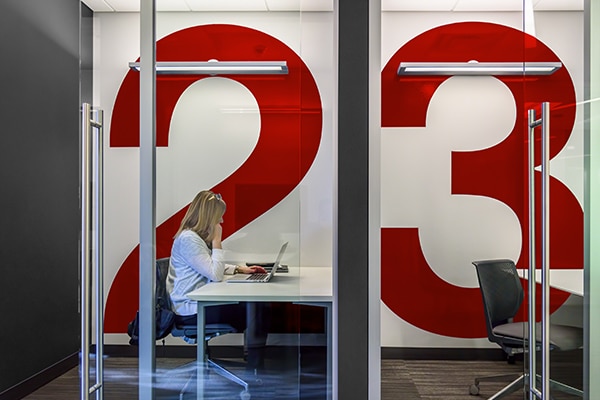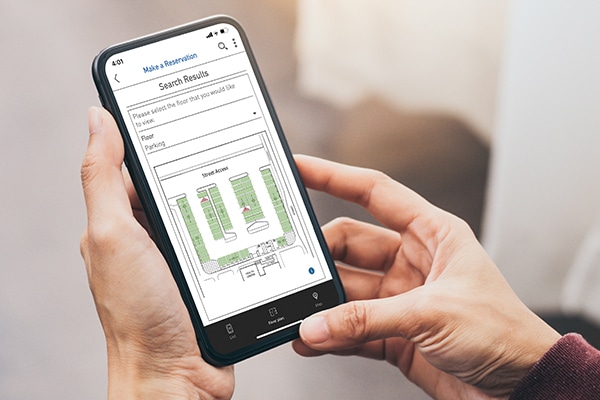Years ago, businesses with large office buildings could get by with a simple reservation system that allowed employees to book meeting rooms. Some workers needed to interact with it less than once a week, while others—often those leading teams of people or managing projects—may have used it a few times a week.
Modern workplaces have a much wider range of needs. And for those using a hybrid model, where employees alternate between working remotely and in person, employees may need to make multiple reservations throughout the day.
But just because the range of applications for your reservation system has broadened doesn’t mean the process has to be any more complex. Robust can still be simple. Your employees don’t have to learn new software or use a dedicated app (unless they prefer it), and all of their reservations can still be managed through intuitive calendar integrations.
Over the years though, some office hoteling software hasn’t evolved to accommodate modern applications. It wasn’t built to handle your diverse needs. Unfortunately, this often results in businesses using multiple processes for reserving different spaces, equipment, and services throughout the organization, creating a messy blend of systems for equipping employees with what they need to be effective and successful.
That doesn’t have to be the case though. By assessing the full range of reservable resources within your business and the capabilities of modern solutions, you can find a desk booking software that meets your needs today and in the years to come. Right now, you may even be using other methods to manage shared resources within your organization when it could all be handled through a single system. Modern tools should give you the flexibility to creatively solve your resource management challenges.
Here are seven types of reservations that modern businesses need to make in office hoteling software.
1. Workspaces
With the rise of hybrid workplaces and alternative models like activity-based working (ABW), it’s increasingly common for employees to alternate between multiple work environments. They may use a different desk every day or switch between several types of workspaces throughout the day.
Additionally, many workplaces—even those that aren’t hybrid or using a model like ABW—may have unique workspaces for those who need a break from their usual assigned workstation. You may have some secluded desks in soundproof rooms, recording studios for podcasts and webinars, treadmill desks for those who want to be more active while they work and think, or reservable offices.

Your office reservation system needs to be able to facilitate reservations of individual spaces to ensure employees can find and claim the workstations they need.
But while workspace reservations have been commonplace in desk booking software for years, not all tools are equal. Today, your hoteling software should include occupancy analytics components—not just the ability to make reservations. With these insights you can learn more about the types of workspaces your employees prefer, when they use them, and more. This will equip you to replicate those features in other workstations (ideally those with higher vacancy rates).

Tango Reserve by AgilQuest helps organizations and its employees recognize usage patterns, identifying where employees prefer to work, when they prefer to work, and perhaps most importantly, who they prefer to work with. Employees can use the People Search functionality to see their coworkers’ reservations for the coming days to help them make their own decisions about what spaces to reserve and times to come in based on those colleagues’ schedules. This is especially valuable in hybrid work environments where employees want to maximize face time and collaboration when they’re in the office.
2. Collaboration spaces
In traditional offices, “collaboration spaces” were limited to meeting rooms and the occasional impromptu desk meeting. But as businesses seek to reinforce the value of their dedicated office space, many are emphasizing collaborative areas, including outdoor spaces, neighborhoods, and specialized meeting rooms optimized for particular kinds of group activities. You may have meeting rooms with smart boards or whiteboards for working through problems and strategizing together, spaces with plenty of screens for collaborating with remote colleagues, rooms designed for presenting information, and more comfortable social spaces.

Whatever employees need to do together, you want to ensure your hoteling software makes it easy for them to see which spaces have adequate seating and any of the amenities, supplies, or equipment they need to be productive. While meeting room reservations are one of the oldest functions of office booking software, not all applications handle it the same way or have the same capabilities. With some calendar integrations, for example, it may be difficult for employees to understand the differences between reservable spaces unless they’re already familiar with them all and the abbreviations the system uses. The more descriptive and intuitive this process can be, the better.

Additionally, it’s worth considering how the reservation system displays the availability of spaces. Ideally, this information should appear in multiple places. When employees try to book a time slot, they should see all available spaces with filtering capabilities or information about how many people the spaces can accommodate, and when they select a specific space they want, it should be clear when it’s available.
3. Equipment
Throughout the workday, some employees may need to reserve several pieces of equipment that may not make sense to connect to a specific workstation. Not everyone needs a locker or storage solution, for example, but hybrid employees may feel more comfortable working on campus when they have a dedicated space to store their personal belongings.
Some roles may also require access to certain supplies. Normally, it makes sense to keep these supplies in a dedicated location, but if a pool of hybrid employees doesn’t have dedicated workstations, it could be more practical to let them reserve a supply cart they can easily move between workstations.
Other employees may need specialized equipment, like cameras and microphones—or even software you have limited licenses for. You might also have equipment for facilitating collaboration between remote and in-person employees, such as telepresence robots. And of course, some of your reservable equipment may be recreational, such as kayaks, sports equipment, games, or even media like movies or books.
Your desk booking software should include functionality for creating custom equipment reservations and organizing them in a way that’s easy for employees to navigate.

As your reservation needs diverge from the typical offerings of desk booking software, unfortunately, many businesses wind up using multiple systems to manage these different types of bookings. Some businesses may opt to use a dedicated software solution for reserving equipment. Others may use informal processes or outdated workarounds like a sign-out chart. But with a little forethought, you can simply make sure you choose a desk booking software that includes equipment reservation capabilities.
Any time you have a greater demand for a piece of equipment than your supply of that equipment can meet, it’s a good candidate for your reservation software. But even if demand is simply variable because the flow of in-person employees changes throughout the week, a modern office booking solution should make that demand more manageable.
4. Services
Some of your reservable internal resources don’t come in the form of physical spaces, equipment, or digital tools. If you offer your employees childcare services, your employees obviously need a simple way to schedule and coordinate that care. Or if there’s a dedicated company driver or a shuttle service to take people around campus, you’d want everyone to see the availability of this service. And even more common services like cleaning and janitorial services or IT support could be reservable.
For example, you may have a rotating pool of employees available on-demand for services, and other employees need a simple way to see their availability and book a time slot. You could require employees to coordinate calendars or have a primary point of contact for scheduling services. But a robust desk booking software solution should be capable of handling this as well.

5. Parking
For employees who don’t use public transportation to commute to and from the office, parking can be a daily source of frustration. Disorganized and unpredictable parking systems can cause delays as employees circle parking lots or patrol city blocks looking for open spots. But if your business has dedicated parking spots, your reservation system can help streamline this process and make it more equitable by enabling employees to reserve parking for the times they’ll be in the office—either reserving spots from home or upon their arrival in the lot itself.

Incorporating parking into your hoteling software also makes it easier for employees to coordinate when they’ll come into the office or how they’ll get there. Hybrid employees, for example, may be required to come in on certain days or a specific number of days each week. With a connected parking reservation system, employees can see if there are parking spots available when they intend to come in, and if not, they can either choose another day to come in or find alternative transportation. Since people use different transportation methods to get to work, the availability of workstations doesn’t necessarily correspond to the availability of parking spaces, so employees can’t just assume that because they can reserve a desk, they can also book a spot for their vehicle.
6. Transportation
Some companies have shared vehicles for employees to use as needed or for special occasions, such as company cars, bikes, scooters, and personal transporters. Unless you’re gifting vehicles to every employee, this is another area where you’re bound to have a small supply of a company resource that there’s greater demand for. You may also have restrictions around who can reserve transportation, how long they can reserve a vehicle for, and how often they can do it—making it crucial to have a well-organized, easily trackable reservation system.

7. Health and wellness rooms
Over the years, one of the amenities employees have advocated for is dedicated space for health and wellness. Many businesses are accommodating this desire with reservable rooms designed for privacy and comfort.
Nursing mothers may want to pump in privacy without subjecting themselves to bathrooms, supply closets, and other uncomfortable environments. People with medical conditions may also need to perform self care, which they may not be able to do in a shared office or the bathroom. At times, an employee may need time and space to rest before they’re able to get back to work. For example, they may have a headache that isn’t bad enough to send them home, but they need a moment for medication to kick in.

Whatever their purpose, you don’t want people knocking on health and wellness rooms to learn whether they’re available. This is a distinct type of reservable amenity that should be incorporated into the same reservation system your employees use for everything else they need throughout the day.
Ultimately, any shared resource that you have a limited supply of should be reservable in the same place, whether it’s a type of space, asset, or service. They’re all things your employees need to schedule, share, and coordinate their plans around—so they should all be accessible from your desk booking software.
Get one solution for all your workplace reservations
Modern workplaces require modern solutions. With the wealth of resources your employees could manage through a single reservation system, it would be absurd to invest in separate tools or create unique workarounds for reservation types that aren’t compatible with an outdated solution.
Tango Reserve by AgilQuest gives you the flexibility you need to make any space, asset, or service reservable, and to set any parameters your organization needs. This centralized workflow keeps things simple for your employees, and manageable for you.
Want to see what Tango Reserve can do for your business?